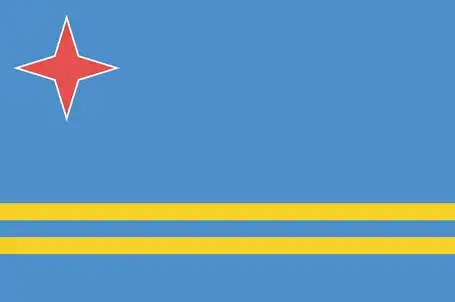Aruba Flag
National Flag of Aruba
Aruba Flag Display

Quick Facts About Aruba and Aruba Flag
- Adopted:
- Aspect Ratio:
- 2:3
- Capital:
- Oranjestad
- Population:
- Approximately 110,000
Flag Description
A siren blue field with two narrow parallel yellow stripes and a red, white‑bordered four‑pointed star in the canton, symbolizing Aruba’s natural beauty and identity.
Symbolism & Meaning of the Aruba Flag
Blue reflects the sea and sky; yellow lines depict sunshine, tourism, and mining; the red star stands for Aruba itself, its four points representing the principal national elements, white border for purity.
Historical Background of the Aruba Flag
Adopted when Aruba achieved separate status within the Kingdom of the Netherlands; designed by W.J. van der Zant to reflect local pride while recognizing Dutch ties.
Design Elements of the Aruba Flag
Sky-blue background with two narrow horizontal yellow stripes in the lower half; red four-pointed star with a white border in the upper hoist corner.
Usage & Protocol of the Aruba Flag
Hoisted on government buildings, public holidays, and during cultural events; governed by Aruba’s national flag regulations.
Frequently Asked Questions
What do the colors of the Aruba Flag represent?
Blue reflects the sea and sky; yellow lines depict sunshine, tourism, and mining; the red star stands for Aruba itself, its four points representing the principal national elements, white border for purity.
When was the Aruba Flag adopted?
The Aruba flag was adopted on March 18, 1976, marking an important milestone in the country's development as an independent nation.
What is the aspect ratio of the Aruba Flag?
The Aruba flag has an aspect ratio of 2:3, which determines the proportional relationship between its width and height for official display purposes.